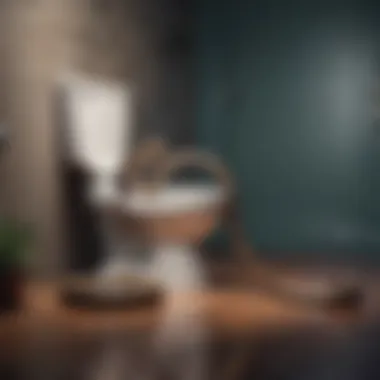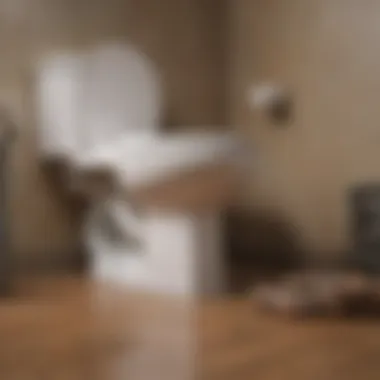Mastering the Art of Using a Plumbing Snake to Unclog Toilets


Intro
Unclogging a toilet is one of the more distressing situations a homeowner can face. A handy plumbing snake offers a practical solution to address stubborn blockages that can disrupt daily life. This guide aims to provide a thorough understanding of how to effectively use a plumbing snake as a primary tool for unclogging toilets.
Understanding the anatomy and functioning of a toilet helps in appreciating why clogs occur. The structure usually includes a bowl, a tank, and a trap. Waste, toilet paper, or foreign objects can create blockages, and a plumbing snake is designed to navigate these inner passages to restore function.
In this article, we will cover the tools needed, step-by-step techniques for using the snake, and troubleshooting tips. We will also discuss preventive measures to reduce the likelihood of future clogs and when to seek professional help.
Tools You Will Need
Before beginning the unclogging process, having the right tools ensures you are prepared. Here are the essentials:
- A plumbing snake (also known as a drain auger)
- A pair of rubber gloves
- A bucket or container for excess water
- Rags or towels for spills
- A flashlight, if necessary, to illuminate the bowl
These tools will enable a smoother and more efficient unclogging process, minimizing mess and maximizing effectiveness.
Step-by-Step Preparation
Preparation is crucial to effectively use a plumbing snake. The following steps serve as an informative checklist:
- Put on rubber gloves to protect your hands and maintain hygiene.
- Turn off the water supply to the toilet, usually located near the floor behind the toilet.
- Flush the toilet to empty the bowl as much as possible, and use a bucket to remove excess standing water if necessary.
- Inspect the trapway for visible obstructions before introducing the snake.
With everything in place, you can confidently proceed to the next step.
Using the Plumbing Snake
Operating a plumbing snake involves a straightforward technique:
- Insert the end of the snake into the toilet bowl, directing it toward the drain opening.
- Crank the handle slowly, which helps the snake progress into the trapway. This motion is essential, as it allows the snake to navigate bends and turns.
- Apply gentle pressure while cranking. You may feel resistance as the snake encounters a clog.
- Continue pushing and rotating the snake until you feel the clog break up or give way.
- Pull the snake out carefully, and observe if any debris comes with it.
- Flush the toilet to check if the water drains properly. If needed, repeat the process.
Troubleshooting Common Issues
Sometimes, unclogging might not go as planned. Here are some common issues that may occur:
- The snake gets stuck: If you encounter resistance with the snake, stop cranking. Lightly pull it back, and then try again.
- Ineffective unclogging: If repeated attempts fail, the clog might be too severe or deep. Consider using a different approach or seeking help.
Always remember, patience is key in this process.
Preventative Measures
Clogs do not always have to be a recurring problem. Here are a few steps to minimize future occurrences:
- Educate family members on what can and cannot be flushed down the toilet.
- Regular maintenance: Use a plumbing snake periodically in areas prone to clogs before any actual blockage occurs.
- Consider using enzyme cleaners to help break down organic material in the pipes.
When to Call a Professional
Though completing the unclogging yourself can be fulfilling, recognizing when to call a professional is equally important. If:
- You encounter persistent clogs despite multiple attempts,
- You suspect a deeper issue within the plumbing,
- The toilet is overflowing consistently,
it may be time to consult an expert.
Understanding Toilet Clogs
Understanding toilet clogs is essential prior to attempting any resolution methods, such as using a plumbing snake. Recognizing the various causes behind clogs allows one to approach the problem with greater knowledge and efficiency. Additionally, being able to identify common signs of a clog equips the user with insights about urgency and appropriate measures to take. This section will examine what causes toilets to clog and help inform the reader about these issues.
Common Causes of Toilet Clogs
Excessive Toilet Paper


Excessive toilet paper is one of the most prevalent reasons for toilet clogs. Users often underestimate how much paper is needed or mistakenly believe that excessive amounts of toilet paper will dissolve quickly. This reliance can lead to significant blockages. A key characteristic of using more paper than necessary is its contribution to solid mass buildup in the toilet trap. In this article, excessive toilet paper serves as a practical example of how user behavior directly influences plumbing issues. Each roll, depending on its thickness, contributes to a solid block that can lead to clogging.
Foreign Objects
Sometimes, foreign objects inadvertently find their way into toilets. Toys, personal hygiene items, and even pet belongings can create unexpected problems. These items often don’t break down in water like toilet paper does. A key aspect of foreign objects is their potential to cause sudden and severe clogs. This type of clog often requires immediate attention, as it can lead to further plumbing complications. This article includes this topic to provoke awareness among users about household habits and proper usage.
Tree Roots
While not commonly recognized indoors, tree roots can affect plumbing systems. Roots can infiltrate sewer lines, causing blockages that manifest as toilet issues. The key factor to consider is how underlying outdoor factors can cause indoor problems. Root growth is typically a gradual process, often underestimated until the situation worsens. Understanding tree roots’ role in clogs provides another layer of context when diagnosing plumbing issues in residential areas.
Mineral Buildup
Mineral buildup is often a silent contributor to toilet clogs, particularly in areas with hard water. Over time, minerals can accumulate within pipes, narrowing the passageway and increasing the likelihood of clogs. A significant characteristic of mineral buildup is its gradual nature, making it easy to overlook until the situation escalates. This topic in the article highlights the need for regular maintenance, offering readers an understanding of preventative measures they can take.
Signs of a Clogged Toilet
Slow Draining Water
Slow draining water is often the first indication of a clog. As the water takes longer to clear, it can serve as a warning sign for potential deeper plumbing issues. A key aspect of slow drainage is how easily it can go unnoticed until it becomes a more severe problem. Recognizing this issue early can help users intervene promptly, thereby mitigating further complications.
Unpleasant Odors
Unpleasant odors can arise as a result of a clog, particularly if waste is caught in the pipes. The smell often signifies stagnation and potential health risks. Its key characteristic is both the discomfort it causes and what it represents regarding plumbing health. Identifying this signal encourages prompt action, allowing users to better maintain their bathrooms and overall plumbing systems.
Frequent Backups
Frequent backups are perhaps the most alarming sign of a clog. Constant blockage not only disrupts daily life but can also lead to more significant plumbing issues. This symptom often indicates an increasingly serious underlying problem. Understanding frequent backups reminds users of the importance of regular inspections and attention to toilet health, making it a crucial topic in this article.
Understanding these elements lays a strong foundation for effectively using a plumbing snake or any other methods to rectify clogged toilets.
Prelude to Plumbing Snakes
Understanding plumbing snakes is essential in the context of unclogging toilets effectively. A plumbing snake is a flexible tool that specialists or DIY enthusiasts use to clear blockages in pipes. It serves as a practical solution for those who experience recurrent toilet clogs. Knowing about plumbing snakes allows individuals to make better choices when dealing with clogs, potentially saving money and time spent on professional plumbing services.
What is a Plumbing Snake?
A plumbing snake, also called a drain auger, is designed to reach and clear obstructions within plumbing systems. It consists of a long, flexible cable that can navigate through pipes, allowing users to break up or remove blockages. The utility of this tool extends beyond toilets; it can also be used in sinks and showers. However, its effectiveness in toilets particularly stands out, as toilets often encounter specific types of clogs.
Types of Plumbing Snakes
Handheld Augers
Handheld augers are one of the most user-friendly options in plumbing snakes. They are commonly used by home users due to their simplicity and effectiveness. The key characteristic of handheld augers is their manual operation, which allows for precise control when navigating through pipes. The advantage of a handheld auger is its ability to reach smaller clogs without excessive force, minimizing the risk of damage to toilets. However, they may require more effort and time, especially for stubborn clogs.
Motorized Snakes
Motorized snakes are another type that brings advanced features to the unclogging process. Unlike handheld augers, these devices use electrical power to operate, which significantly reduces physical effort. The key characteristic of motorized snakes is their speed, making them a popular choice for professionals who need to clear multiple blockages in a timely manner. They can handle tougher clogs with ease. One downside could be the higher cost and the need for proper handling to avoid further damage to plumbing systems.
Flat Tape Snakes
Flat tape snakes, often referred to as toilet augers, specifically address toilet clogs. Their unique flat shape is designed to prevent damage to porcelain when inserted into the toilet. This characteristic makes flat tape snakes a safe choice for users concerned about potential scratches or cracks. They are user-friendly and usually effective in clearing common toilet obstructions. However, they might not penetrate deeper clogs as effectively as other types, limiting their range of application.
Choosing the Right Snake for Your Needs
Choosing the right plumbing snake depends on several factors, such as the severity of the clog, available tools, and personal skill level. For light clogs, a handheld auger may suffice. In contrast, for more serious clogs, investing in a motorized snake could prove beneficial. It's important to assess the situation carefully before deciding which tool to use.
Preparing for the Unclogging Process
Addressing clogged toilets effectively begins with proper preparation. Being ready ensures the situation is managed efficiently and minimizes potential mess or damage. Preparing involves collecting the necessary tools, assessing the clog's severity, and clearing the area for safe access. Skipping these steps can lead to inefficiency, frustration, and increased risk of damage to the toilet or plumbing system.


Gathering Necessary Tools
Plumbing Snake
The plumbing snake is an essential tool in this unclogging process. It is designed to reach blockages that a standard plunger cannot. A key characteristic is its flexible, coiled design, enabling it to navigate bends within the plumbing. This makes it a popular choice since it can effectively break through stubborn clogs caused by various materials. One unique feature of many plumbing snakes is their ability to extend, which allows users to reach deeper blockages. However, it is crucial to handle them carefully to avoid damaging the toilet or causing injury.
Protective Gear
Using protective gear is vital while unclogging a toilet. Gloves are the most critical aspect of this, as they provide a barrier against germs and bacteria present in waste. Choosing thick, durable gloves will offer better protection while working in such conditions. Additionally, wearing old clothes or a waterproof apron is recommended to shield against splashes. The unique feature of protective gear is its role in hygiene and safety, allowing individuals to focus on the task without health risks. Neglecting protective measures can lead to exposure to harmful contaminants.
Toweling Materials
Toweling materials are also necessary for ensuring cleanliness. These include absorbent towels or rags to manage spills effectively. A key characteristic is their absorbency, which helps contain messes from the unclogging process. An important benefit of having toweling materials on hand is the ability to quickly clean any splashes, maintaining a sanitary environment. However, using the wrong type of material could lead to additional problems, such as lint or residue left behind.
Assessing the Clog Severity
Understanding the severity of the clog is a critical step. This can help determine what method and tools are best suited for the job. A minor clog might need only a simple plumbing snake or a plunger, while severe blockages may necessitate more aggressive measures or specialized tools. Noticing signs like slow drainage or repeated inconveniences can signal varying levels of clog intensity, affecting overall strategy.
Clearing the Area
Before starting, it is essential to clear the space around the toilet. This involves moving any nearby items that may interfere with access. A clear area reduces the risk of accidents and provides a safer working environment. Creating adequate space allows for easier movement and enables quick response to unexpected spills. Furthermore, having everything organized enhances focus on the task at hand.
Step-by-Step Guide to Using a Plumbing Snake
Using a plumbing snake can seem daunting, but it is an effective method for unclogging a toilet. Understanding each step is crucial for success. This section breaks down the process, ensuring you can take control of the situation. Each step builds on previous actions, making it easier to follow along and achieve a clear path through the clog. It is about using the right techniques to minimize frustration and maximize results.
Inserting the Snake into the Toilet
To start, you need to gather your tools, especially the plumbing snake. After you have that ready, you can begin by inserting the snake into the toilet bowl. You should do this very carefully. Hold the handle of the snake firmly and guide the tip into the opening. Make sure not to force it, as this can cause damage to the toilet.
Insert the snake gently until you feel resistance. The resistance indicates that you are at the clog’s location. Be patient at this stage. Align the snake correctly to avoid obstruction and ensure it can push through effectively.
Pushing Through the Clog
Once the snake is correctly inserted, begin to push it through the clog. Gently rotate the handle of the snake as you apply pressure. This motion helps the snake dig deeper into the clog. It is not uncommon for the clog to give way after continued pressure.
Should you feel that the snake is stuck, do not panic. Ease back slightly, then push forward again. Be aware that some clogs can be firm, requiring more effort and patience. This phase relies on persistence.
Releasing the Clog
After pushing through the clog, the next step is to release it. Keep turning the handle. This action will help break apart the material causing the blockage. You might hear sounds indicating that the snake is working its way through. It is crucial to remain calm and avoid excessive force.
If the clog clears, you will feel the snake move freely through the pipes. This is a sign you have successfully dislodged the blockage. Run water through the toilet to ensure everything flows smoothly. If problems persist, repeat the process carefully.
Cleaning Up After the Process
Regardless of the success of unclogging the toilet, cleaning up is essential. First, remove the snake from the toilet, keeping a towel ready. Wipe any residue from the snake and dispose of any clog material properly. It is important to maintain hygiene after handling the snake.
Lastly, flush the toilet to check that water flows freely. If it does, congratulations on a job well done. If there are still blockages, you may consider repeating the steps or seeking help.
Remember: Regular cleaning can minimize future clogs and make future attempts easier.
Troubleshooting Common Issues
Troubleshooting common issues is an essential part of managing toilet clogs effectively. Not every clog can be resolved with straightforward methods. Some specific challenges may arise, requiring different techniques or considerations. Understanding these common issues can help you maintain a functional toilet and prevent further inconvenience.
What to Do if the Snake Gets Stuck
Occasionally, during the unclogging process, the plumbing snake might get stuck. This can happen for several reasons, including hitting a bend in the pipe or encountering a particularly stubborn obstruction. Here are steps to deal with this situation:
- Do Not Force It: Apply gentle pressure to avoid damaging the snake or the pipes. Forcing the snake can cause breakage.
- Backtrack Slowly: Gently wind the snake back, trying to recognize where it may have lodged itself.
- Assess the Angle: If the snake is stuck at a particular angle, changing position slightly might free it.
- Consider Lubrication: If feasible, applying a small amount of lubricant around the snaked area may help.
In more complex situations, evaluate if the snake needs to be replaced or if professional help is required.
When the Clog Resists


Sometimes, even after multiple attempts to snake the toilet, the clog persists. This situation may arise due to numerous factors, such as heavy sediment buildup or invasive foreign objects deeper in the plumbing. Here are a few strategies to address a resistant clog:
- Use a Water Jet: If available, a high-pressure water jet can break apart stubborn blockages effectively.
- Retry Different Snake Types: Some clogs respond better to specific types of snakes. A motorized snake may be more effective than a handheld one.
- Break Down Solids: Products like enzymatic drain cleaners can chemically break down organic blockages, making them easier to remove without physical force.
- Check for Tree Roots: If your plumbing lines are infiltrated by roots, they may need mechanical trimming or a more intensive solution.
Remember, if multiple attempts fail, it might be best to consult a professional plumber, as they have specialized tools and knowledge to handle complex plumbing issues.
Preventative Measures for Future Clogs
Preventative measures are crucial in managing toilet clogs. They not only reduce the frequency of clogs but also ensure the plumbing system functions efficiently. Implementing simple yet effective strategies can save time, frustration, and expensive plumber fees. In this section, we will delve into proper toilet usage and regular maintenance practices as key elements for preventing future clogs.
Proper Toilet Usage
Understanding how to use a toilet properly is essential to prevent clogs. Some habits contribute significantly to clog formation. For example, excessive flushing of toilet paper is one of the largest causes of blockages. Using less toilet paper or achieving a balance in how much you use can drastically reduce clogs.
Moreover, it is critical to avoid flushing anything that isn't human waste or toilet paper. Items like cotton balls, diapers, or sanitary napkins can easily cause blockages. Ensuring all household members are aware of correct toilet usage is beneficial. Clear communication can reinforce the critical habits needed to prevent clogs.
Regular Maintenance Practices
Regular maintenance practices can be an effective way to minimize clogs and keep the plumbing system healthy.
Routine Inspections
Routine inspections are a proactive way to spot early signs of issues before they escalate. Regular checks on the toilet can help identify problems like minor leaks or buildup that could lead to more severe clogs. The key characteristic of these inspections is that they are easy and require minimal tools.
Advantages of routine inspections include:
- Early detection of minor issues
- Increased lifespan of toilet and plumbing
- Reduced emergency repairs with potential costly outcomes
However, one needs to be diligent. Skipping inspections could lead to ignored problems that eventually result in clogs.
Using Enzymatic Cleaners
Using enzymatic cleaners is another beneficial practice for toilet maintenance. These cleaners break down organic material that might lead to blockages, promoting cleaner pipes. Their key characteristic is safety; they do not contain harsh chemicals that might damage plumbing systems.
The unique feature of enzymatic cleaners is that they are environmentally friendly and can be used regularly without negative consequences. Their advantages include:
- Non-toxic formulation
- Efficient breakdown of waste materials
- Promotion of healthier plumbing systems
However, it is important to note that while these cleaners can aid in preventing clogs, they should not replace mechanical methods when severe blockages occur.
Incorporating these preventative measures into your routine can lead to a smoother functioning toilet. A small effort in maintenance today can prevent bigger problems tomorrow.
When to Call a Professional Plumber
Knowing the right time to contact a professional plumber can remove the stress and frustration related to persistent toilet clogs. There are situations when DIY methods do not suffice. This section outlines those moments when professional help is not just recommended but necessary for resolving plumbing issues properly.
Persistent Clogs
Persistent clogs will frustrate any homeowner, triggering the need for expert intervention. If your toilet remains backed up consistently, despite your attempts to unclog it with a plumbing snake, you should consider reaching out to a plumber.
Many factors could contribute to a persistent clog:
- Severe blockages that are beyond the capacity of standard tools.
- Multiple clogged fixtures in your home, indicating a deeper issue.
- Recurrences after multiple treatments, which suggest an underlying problem rather than just a transient clog.
Ignoring these signs can lead to worsening conditions, such as overflowing toilets or water damage to the flooring. Thus, professional plumbers utilize specialized equipment and diagnostic tools to identify the source of the issues.
Underlying Plumbing Issues
Sometimes, a simple clog acts as a symptom of a far more complex problem within your plumbing system. Underlying issues can include tree root invasion in your sewer lines, damaged pipes, or even systemic issues with the drainage system.
Here are a few indicators that an underlying problem may exist:
- Unusual sounds (gurgling or bubbling) when using nearby drains.
- Foul odors emanating from your plumbing.
- Slow drainage not just in the toilet, but across multiple fixtures.
In these cases, a plumber can conduct essential inspections, often using cameras to view the insides of pipes without invasive techniques. Their expertise ensures that serious plumbing problems get addressed promptly, avoiding further complications.
It's crucial to act decisively if you notice persistent clogs or unusual plumbing signs. Doing so can save you time and money in the long run.







